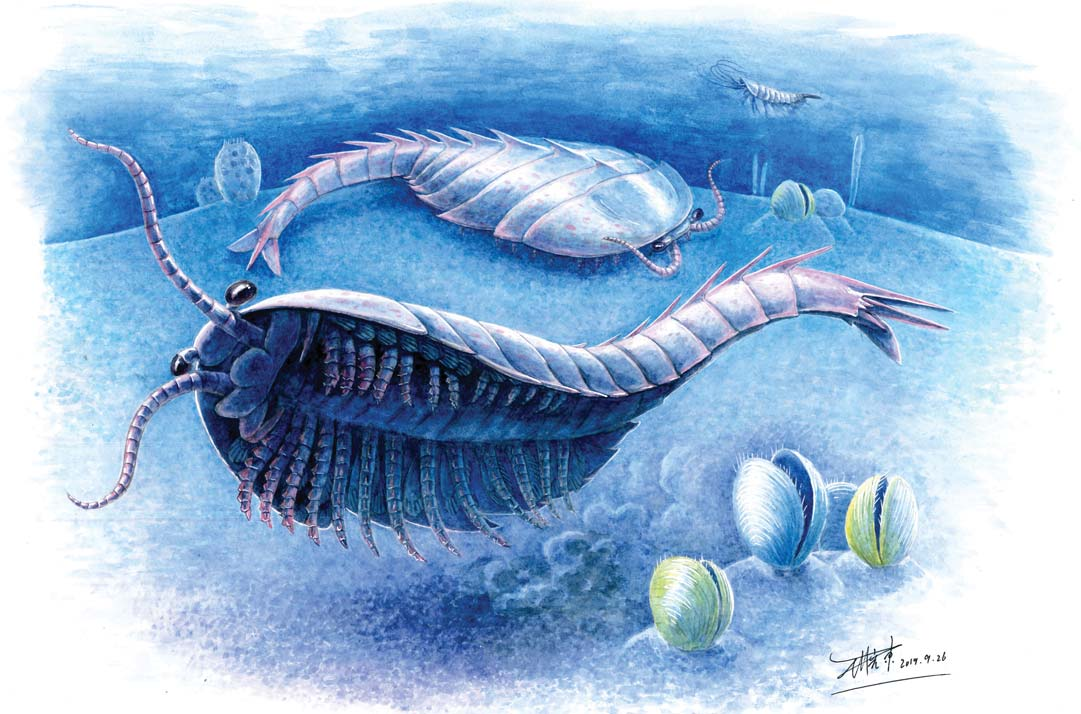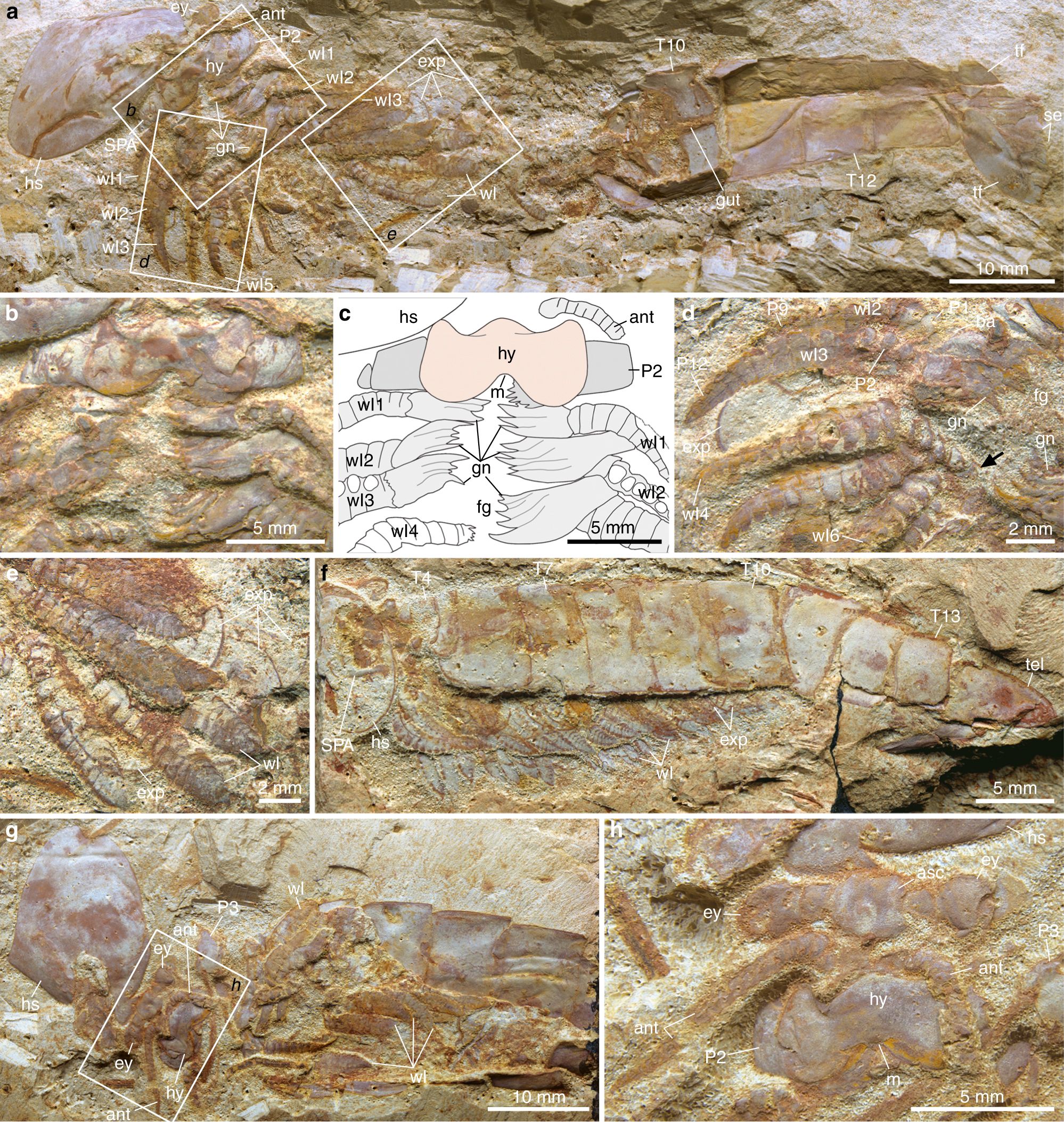|
Fuxianhuiid
Fuxianhuiida is an extinct clade of arthropods from the Cambrian of China. All currently known species are from Cambrian Series 2 aged deposits in Yunnan Province, including the Chengjiang biota. They are generally considered to be close to the base of Euarthropoda, but have also been considered to be early mandibulates. Many specimens are known with exceptional soft tissue preservation, including preserved guts and neural tissue, which given their basal phylogenetic position makes them important in understanding the evolution of arthropoda as a whole. They reach a size of up to 15 cm, and are interpreted as benthic predators and scavengers. The fuxianhuiid exoskeleton is unmineralised, and the number of tergites ranges from 15 to over 40. The cephalon is covered by a head shield and contains stalked eyes connected by the anterior sclerite, antennae, a butterfly shaped hyposome and a posterior facing mouth. Fuxianhuiids possess specialized post-antennal appendages with ser ... [...More Info...] [...Related Items...] OR: [Wikipedia] [Google] [Baidu] |
Guangweicaris
''Guangweicaris'' is an extinct genus of fuxianhuiid arthropod known from the Cambrian period. It is only known from the type species ''Guangweicaris spinatus'', which is known from the Cambrian Stage 4 Guanshan Biota near Kunming. It is currently the latest known fuxianhuiid. It was first described in 2007, and was given a comprehensive re-description in 2020. It is currently known from over 150 specimens. Within the fuxianhuiids it is sister to ''Fuxianhuia'', together forming the clade Fuxianhuiidae. In comparison to ''Fuxianhuia'' it has a wide, oval shaped opisthothorax and a proportionally longer, narrow tail-like abdomen, with 3 prothoracic tergites A ''tergum'' (Latin for "the back"; plural ''terga'', associated adjective tergal) is the dorsal ('upper') portion of an arthropod segment other than the head. The anterior edge is called the 'base' and posterior edge is called the 'apex' or 'mar ..., 5 opisthothoracic tergites and 7 abdominal tergites, it also possesses a ro ... [...More Info...] [...Related Items...] OR: [Wikipedia] [Google] [Baidu] |
Alacaris Restoration
''Alacaris'' is an extinct genus of fuxianhuiid arthropod known from the Cambrian period. It is only known from the type species ''Alacaris mirabilis'' (mistakenly named ''Alacaris multinoda'' in a figure in the describing paper) from the Cambrian Stage 3 aged Xiaoshiba Lagerstätte in Yunnan Province, China. It is morphologically similar to '' Chengjiangocaris'', with which it forms a clade within Fuxianhuiida. Individuals reach a maximum of 12 centimetres in length, with a trunk consisting of 13 tergites A ''tergum'' (Latin for "the back"; plural ''terga'', associated adjective tergal) is the dorsal ('upper') portion of an arthropod segment other than the head. The anterior edge is called the 'base' and posterior edge is called the 'apex' or 'mar .... The basal region of the post- deutocerebral limbs were used in feeding, with the rhythmic movement of the legs guiding food towards the mouth along the food groove between the limbs, with gnathobases present near the mouth to m ... [...More Info...] [...Related Items...] OR: [Wikipedia] [Google] [Baidu] |
Alacaris
''Alacaris'' is an extinct genus of fuxianhuiid arthropod known from the Cambrian period. It is only known from the type species ''Alacaris mirabilis'' (mistakenly named ''Alacaris multinoda'' in a figure in the describing paper) from the Cambrian Stage 3 aged Xiaoshiba Lagerstätte in Yunnan Province, China. It is morphologically similar to '' Chengjiangocaris'', with which it forms a clade within Fuxianhuiida. Individuals reach a maximum of 12 centimetres in length, with a trunk consisting of 13 tergites A ''tergum'' (Latin for "the back"; plural ''terga'', associated adjective tergal) is the dorsal ('upper') portion of an arthropod segment other than the head. The anterior edge is called the 'base' and posterior edge is called the 'apex' or 'mar .... The basal region of the post- deutocerebral limbs were used in feeding, with the rhythmic movement of the legs guiding food towards the mouth along the food groove between the limbs, with gnathobases present near the mouth to m ... [...More Info...] [...Related Items...] OR: [Wikipedia] [Google] [Baidu] |
Chengjiangocaris
''Chengjiangocaris'' is an extinct genus of fuxianhuiid arthropod known from the Cambrian of South China. It contains two species, ''C. longiformis'' which was described in 1991. ''C. kunmingensis'' was described in 2013 by Javier Ortega-Hernández and colleagues. One specimen of ''C. kunmingensis'' shows detailed evidence of a nervous system. Anatomy ''C. kunmingensis'' has 20 anterior trunk tergites and up to 16 narrow anterior tergites. Phylogeny After References Further reading *Jie Yang et al.Fuxianhuiid ventral nerve cord and early nervous system evolution in Panarthropoda - abstract Proceedings of the National Academy of Sciences ''Proceedings of the National Academy of Sciences of the United States of America'' (often abbreviated ''PNAS'' or ''PNAS USA'') is a peer-reviewed multidisciplinary scientific journal. It is the official journal of the National Academy of Sci ..., subscription required for full article *Javier Ortega-HernándezOpinion: Our 500 ... [...More Info...] [...Related Items...] OR: [Wikipedia] [Google] [Baidu] |
Fuxianhuia
''Fuxianhuia'' is a genus of Lower Cambrian fossil arthropod known from the Chengjiang fauna in China. Its purportedly primitive features have led to its playing a pivotal role in discussions about the euarthropod stem group. Nevertheless, despite being known from many specimens, disputes about its morphology, in particular its head appendages, have made it one of the most controversial of the Chengjiang taxa, and it has been discussed extensively in the context of the arthropod head problem. The genus is named after Fuxian Lake (''Fuxian Hu''), where it was unearthed. Its specific name (zoology), specific name ''wikt:protensus, protensa'' refers to its extended trunk. Description Complete ''Fuxianhuia'' specimens are approximately 4 centimetres long. The anterior of ''Fuxianhuia'' is encased in an oval sclerite, from which two stalked eyes emerge. Inserting directly behind this sclerite, on the head shield proper, are two stout antennae. When the head of ''Fuxianhuia'' wa ... [...More Info...] [...Related Items...] OR: [Wikipedia] [Google] [Baidu] |
Tergum
A ''tergum'' (Latin for "the back"; plural ''terga'', associated adjective tergal) is the Anatomical terms of location#Dorsal and ventral, dorsal ('upper') portion of an arthropod segment other than the head. The Anatomical terms of location#Anterior and posterior, anterior edge is called the 'base' and posterior edge is called the 'apex' or 'margin'. A given tergum may be divided into hardened plates or sclerites commonly referred to as tergites. In a Thorax (insect anatomy), thoracic segment, for example, the tergum may be divided into an anterior notum and a posterior Scutellum (insect), scutellum. Lateral extensions of a tergite are known as paranota (Greek for "alongside the back") or ''carinae'' (Latin for "keel"), exemplified by the flat-backed millipedes of the order Polydesmida. Kinorhynchs have tergal and sternal plates too, though seemingly not homologous with those of arthropods. Tergo-tergal is a stridulation, stridulatory mechanism in which fine spines of the abdom ... [...More Info...] [...Related Items...] OR: [Wikipedia] [Google] [Baidu] |
Sexual Dimorphism
Sexual dimorphism is the condition where the sexes of the same animal and/or plant species exhibit different morphological characteristics, particularly characteristics not directly involved in reproduction. The condition occurs in most animals and some plants. Differences may include secondary sex characteristics, size, weight, colour, markings, or behavioural or cognitive traits. These differences may be subtle or exaggerated and may be subjected to sexual selection and natural selection. The opposite of dimorphism is ''monomorphism'', which is when both biological sexes are phenotypically indistinguishable from each other. Overview Ornamentation and coloration Common and easily identified types of dimorphism consist of ornamentation and coloration, though not always apparent. A difference in coloration of sexes within a given species is called sexual dichromatism, which is commonly seen in many species of birds and reptiles. Sexual selection leads to the exaggerated dim ... [...More Info...] [...Related Items...] OR: [Wikipedia] [Google] [Baidu] |
Durophagy
Durophagy is the eating behavior of animals that consume hard-shelled or exoskeleton bearing organisms, such as corals, shelled mollusks, or crabs. It is mostly used to describe fish, but is also used when describing reptiles, including fossil turtles, placodonts and invertebrates, as well as "bone-crushing" mammalian carnivores such as hyenas. Durophagy requires special adaptions, such as blunt, strong teeth and a heavy jaw. Bite force is necessary to overcome the physical constraints of consuming more durable prey and gain a competitive advantage over other organisms by gaining access to more diverse or exclusive food resources earlier in life. Those with greater bite forces require less time to consume certain prey items as a greater bite force can increase the net rate of energy intake when foraging and enhance fitness in durophagous species. In the order Carnivora there are two dietary categories of durophagy; bonecrackers and bamboo eaters. Bonecrackers are exemplified by hy ... [...More Info...] [...Related Items...] OR: [Wikipedia] [Google] [Baidu] |
Hypostome (trilobite)
The hypostome is the hard mouthpart of trilobites found on the ventral side of the cephalon (head). The hypostome can be classified into three types based on whether they are permanently attached to the rostrum or not and whether they are aligned to the anterior dorsal tip of the glabella. Morphology The center of the hypostome is an ovoid, typically convex part called the median body, often divided into an anterior lobe and a posterior lobe. Either side of the median body is a border with various extensions, including anterior and posterior wings, sometimes bearing knob-like processes. The hypostome is hollow, and encloses the mouthparts, the anterior digestive tract, and the bases of the antennae. Trilobite antennae pass through notches between the anterior and posterior wings, then forward. The anterior wings are designed to rest firmly against internal structures (ventral apodemes) on the glabella. Variation in trilobite hypostome morphology is crucial in modern discussi ... [...More Info...] [...Related Items...] OR: [Wikipedia] [Google] [Baidu] |
Antenna (biology)
Antennae ( antenna), sometimes referred to as "feelers", are paired appendages used for sensing in arthropods. Antennae are connected to the first one or two segments of the arthropod head. They vary widely in form but are always made of one or more jointed segments. While they are typically sensory organs, the exact nature of what they sense and how they sense it is not the same in all groups. Functions may variously include sensing touch, air motion, heat, vibration (sound), and especially smell or taste. Antennae are sometimes modified for other purposes, such as mating, brooding, swimming, and even anchoring the arthropod to a substrate. Larval arthropods have antennae that differ from those of the adult. Many crustaceans, for example, have free-swimming larvae that use their antennae for swimming. Antennae can also locate other group members if the insect lives in a group, like the ant. The common ancestor of all arthropods likely had one pair of uniramous (unbranched ... [...More Info...] [...Related Items...] OR: [Wikipedia] [Google] [Baidu] |
Cephalon (arthropod Head)
The cephalon is the head section of an arthropod. It is a tagma, i.e., a specialized grouping of arthropod segments. The word cephalon derives from the Greek κεφαλή (kephalē), meaning "head". Insects In insects, ''head'' is a preferred term. The insect head consists of five segments, including three (the labial, maxillary and mandibular) necessary for food uptake, which are altogether known as the gnathocephalon and house the suboesophageal ganglion of the brain, as well as the antennal segment, and an ocular segment, as well as a non segmented fused section of the head where the archicerebrum is housed known as the acron. See also arthropod head problem. Chelicerates and crustaceans In chelicerates and crustaceans, the cephalothorax is derived from the fusion of the cephalon and the thorax, and is usually covered by a single unsegmented carapace. In relation with the arthropod head problem, phylogeny studies show that members of the Malacostraca class of cru ... [...More Info...] [...Related Items...] OR: [Wikipedia] [Google] [Baidu] |







.png)